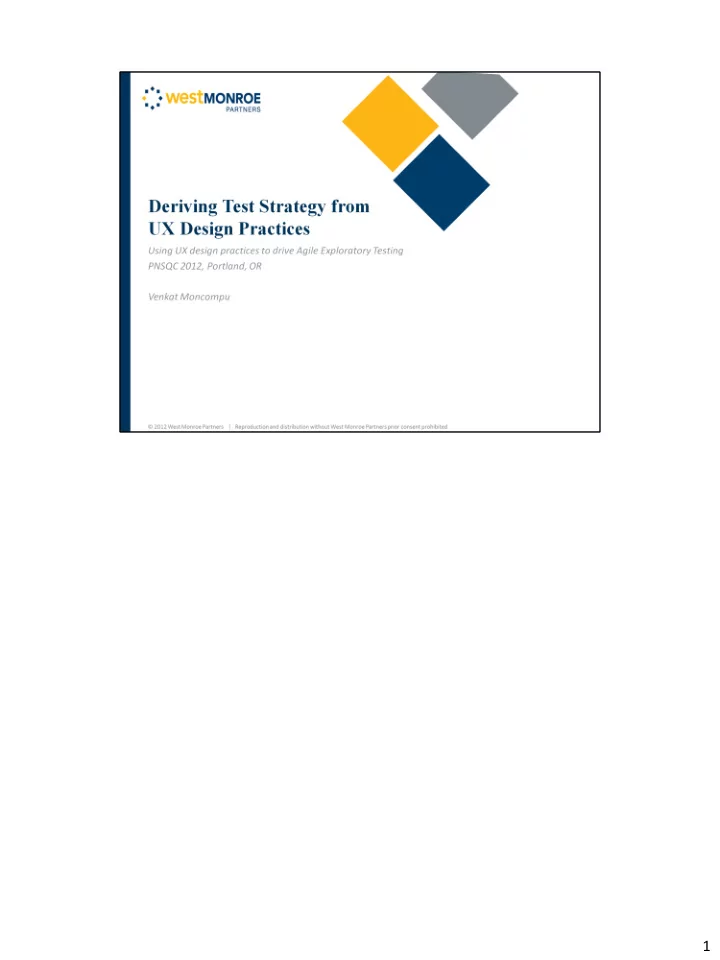

1
2
3
4
• Most of the traditional approaches that drive test strategies are based on some attributes that is derived from other assessments such as requirements-driven, risk-driven or metrics-driven test strategies. • The problem with these approaches is that they are: • Inside-out view of the solution rather than an outside-in. • Prescriptive rather than being adaptive. • Test strategies are closely aligned with development methodology. • Test strategies have to be dynamic and adaptive. • Test strategies should not merely assess quality as a function of stated requirements, they should continuously assess “ fitness-for-use .” • Agile methodology provides the right adaptive framework. 5
• Exploratory testing techniques (ET) have been developed not only as a best- practice for testing but also found to be most suited for agile testing. • Agile methodology manages risks incrementally – eliminates big-bang integration issues with quality. • Lisa Crispin in her book agile testing describes metaphorically that a project is like a car that is on cruise control but the terrain and the trajectory are also unknown. • Automation accelerators are practiced today which eliminate Technical Debt (script-less automation and improved object recognition algorithms) – Ward Cunningham first coined technical debt in 1992. 6
• Over time the technical debt grows exponentially – and becomes insurmountable. • There is never time to do it right, but doing it wrong will lead to failure. This is the number one cause of poor products from a development perspective. • Ken Schwaber and Jeff Sutherland provide some original insights into this term which was first coined by Ward Cunningham in 1992. 7
• Exploratory testing techniques are not to be confused with ad-hoc or random testing and is highly adaptive and based on feedback which is the key tenet of agile software development. • Time-boxed evaluation of the solution space within the bounds of a charter and followed by a retrospective. • What I am proposing here is to leverage User Experience (UX) Design process as a strategy for exploratory testing strategy and guide test execution. 8
James Bach’s minefield analogy: Repeatedly running the same scripted tests over and over again reduces the chances of uncovering any new bugs just as walking on the footsteps of another in a minefield is unlikely to set off any new mines. 9
Session based test management (SBTM) is a popular exploratory testing technique. You can use the UX design as a framework to SBTM. 10
Jesse James Garrett’s elements of UX describe the activities and functions at each plane during a UX design process. 11
• Knowing what the user really needs and catering to those needs make-or-break any system. • Customer is always right and does not know what she wants until she sees it. 12
• Very often development teams focus only on the one user that it targets the solution to. And sometimes, the teams break these users by business hierarchy or functional groups. • For acceptance and ‘fitness for use’ though, end -users have to be studied and true acceptance criteria established within the context of these users. A lot of times the true end-users are not accessible to the development teams as well. 13
• Target user-base is established. Number of personas depends on the extent of this user-base. • Basis for understanding users in the context of their environment. 14
• Essential use cases (Constantine & Lockwood) describe the interaction with a system in a technology and implementation independent manner. • Task optimization studies conducted in-context under the actual operating and working conditions of the user. • User stories are the feature lists that developers and testers use to develop the solution. Scenarios are the vehicles through which user stories manifest. • Good user stories follow the INVEST paradigm. Define a valuable user value story – implement and test it in a short iteration - demonstrate/and or deliver it to the user – capture feedback – learn – repeat forever! – Dean Leffingwell 15
• Locality of reference • Categorization and cataloging of content 16
• While reviewing skeletal layer, evaluating the structure of the presentation with a given task at hand, the “location” in the software becomes the context of interaction • It is not enough to test linearly for a static goal from a given context. Personas and end-to-end scenarios which span multiple tasks provide the framework for evaluation of navigation and interaction because interaction contexts change as task goals change for the persona. 17
Designing for the lowest common denominator, forgiving application – one that is resilient. Heuristic assessment: Easy access to content, guidance to workflow and conversion funnel. Affordance is the quality of the object allowing an action-relationship with an actor. 18
19
• When exploration is guided by the user strategy, scenarios become the vehicles that drive the acceptance assessment. • Scenario + personas => tool for their tasks 20
21
22
23
24
25
• Demographic – typical population based categorization without consideration of other factors • Psychographic – based on social class, lifestyle, personality characteristics • Ron Jeffries of XP programming fame describes 3Cs – Card, Conversation and Confirmation 26
27
• User attributes govern the way the different personas use the system. • They serve to be the bounds of the design space – and so provide the space for exploration. 28
29
30
31
32
33
34
35
36
37
Recommend
More recommend